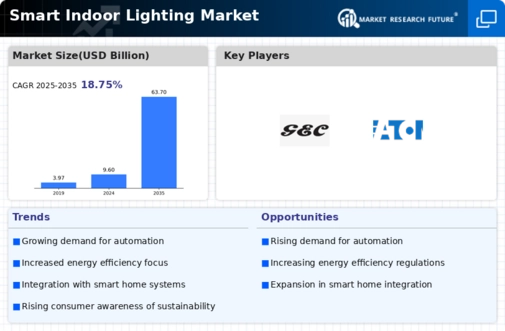Rising Demand for Energy Efficiency
The Global Smart Indoor Lighting Market Industry experiences a notable surge in demand for energy-efficient solutions. As energy costs continue to rise, consumers and businesses alike seek ways to reduce their energy consumption. Smart indoor lighting systems, which utilize LED technology and intelligent controls, can reduce energy usage by up to 80 percent compared to traditional lighting. This shift not only lowers utility bills but also contributes to environmental sustainability. The market is projected to reach 9.6 USD Billion in 2024, reflecting a growing awareness of energy efficiency benefits among consumers and businesses globally.
Government Initiatives and Regulations
Government initiatives aimed at promoting energy efficiency and sustainability significantly impact the Global Smart Indoor Lighting Market Industry. Many countries implement regulations that encourage the adoption of energy-efficient lighting solutions, including tax incentives and rebates for consumers and businesses. These initiatives are designed to reduce carbon footprints and promote environmental stewardship. For instance, various governments have set ambitious targets for reducing greenhouse gas emissions, which indirectly boosts the demand for smart lighting solutions. As regulatory frameworks evolve, they are likely to further stimulate market growth and adoption of smart indoor lighting technologies.
Growing Awareness of Health and Well-being
There is an increasing recognition of the impact of lighting on health and well-being, which influences the Global Smart Indoor Lighting Market Industry. Research indicates that appropriate lighting can enhance mood, productivity, and overall quality of life. Smart indoor lighting systems allow users to adjust color temperatures and brightness levels, creating environments that promote well-being. This awareness is particularly relevant in workplaces and educational institutions, where lighting can affect performance and comfort. As more individuals and organizations prioritize health-oriented lighting solutions, the market is expected to expand, driven by this growing focus on well-being.
Increased Focus on Smart Homes and Buildings
The trend towards smart homes and buildings is a driving force behind the Global Smart Indoor Lighting Market Industry. As consumers increasingly adopt smart home technologies, the demand for integrated lighting solutions rises correspondingly. Smart indoor lighting systems can seamlessly connect with other smart devices, such as thermostats and security systems, creating a cohesive smart environment. This integration not only enhances convenience but also improves energy management. The growing popularity of smart homes is likely to propel the market forward, contributing to a compound annual growth rate of 18.78 percent from 2025 to 2035.
Technological Advancements in Lighting Solutions
Technological innovations play a pivotal role in the expansion of the Global Smart Indoor Lighting Market Industry. The integration of Internet of Things (IoT) technology into lighting systems enables users to control lighting remotely through smartphones and other devices. This level of control enhances user convenience and personalization, allowing for tailored lighting experiences. Furthermore, advancements in sensor technology facilitate automated adjustments based on occupancy and ambient light levels, optimizing energy use. As these technologies evolve, the market is expected to grow significantly, with projections indicating a rise to 63.7 USD Billion by 2035.













Leave a Comment